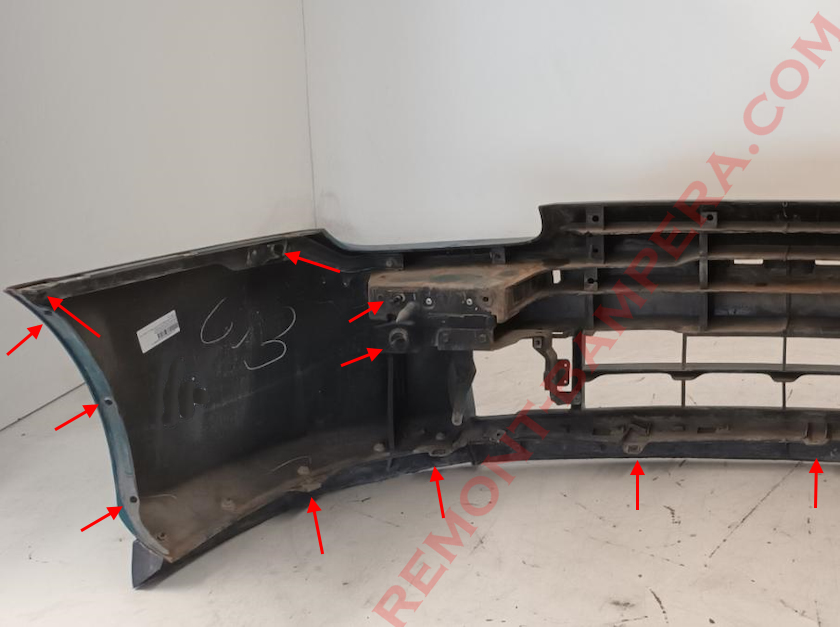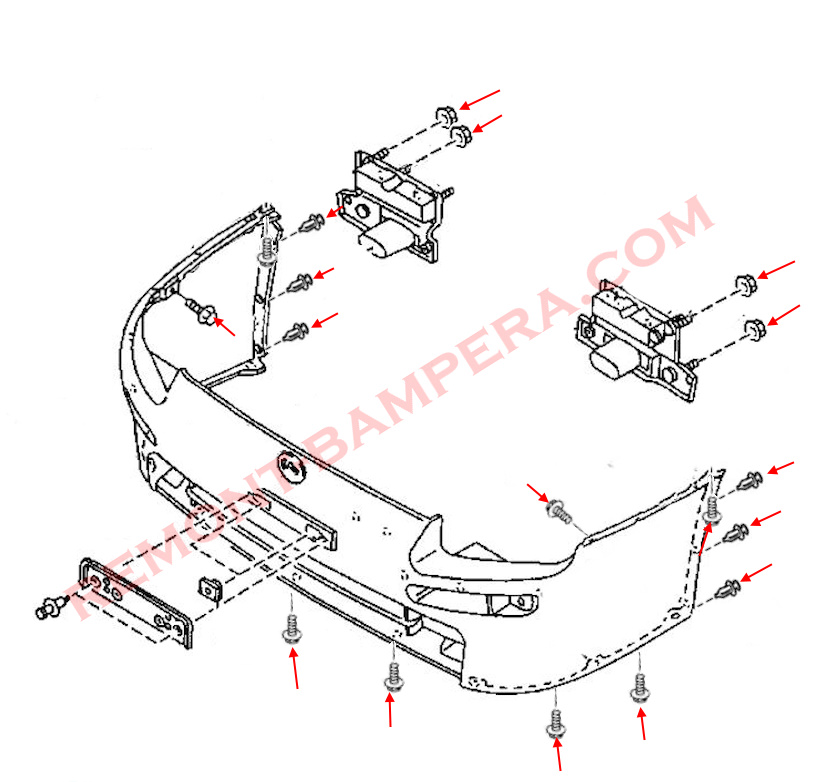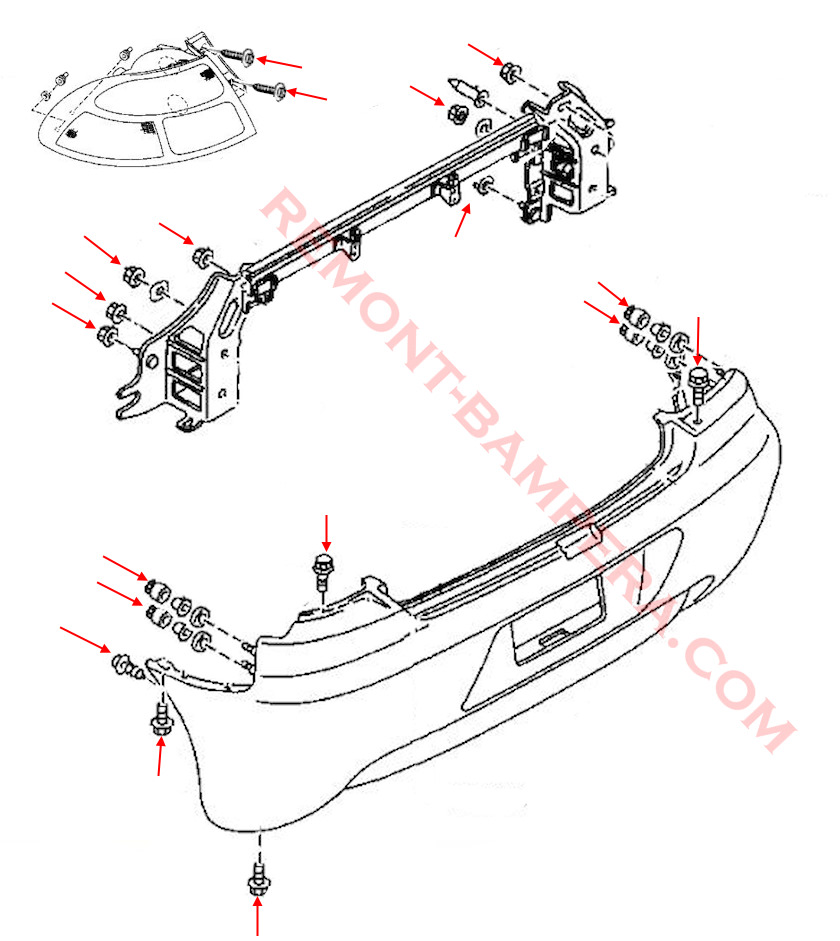Mazda 323F (1993–1998) How to remove bumpers.
Mazda 323F and Mazda Lantis are two names for the same model produced from 1993 to 1998. In different regions, the car was sold under different names:
- Europe, Australia, Japan (hatchback): Mazda 323F (in Japan also called Astina)
- Japan (sedan): Mazda Lantis
- North America: Mazda Protegé (sedan)
- Some Asian markets: Mazda Familia
Despite the different names, it was the same Mazda BG platform, the fifth generation of Mazda 323.
Model Codes and Body Types
The car was produced in several body styles:
- Mazda 323F (BA/BH): 5-door liftback (in Europe), 3-door hatchback (in Japan - Astina)
- Mazda Lantis (BA): 4-door sedan (primarily for Japanese market)
- Mazda 323C (for Japan): 2-door coupe (rare version)
Production Years
- 1993–1998 - in Europe and some other markets (due to delay in sixth generation release)
- 1993–1997 - in Japan (Lantis and 323F Astina)
Bumper Plastic Marking: >PP<
How to Remove Front Bumper
- Open the hood.
- It will be easier if you remove the headlights.
- In wheel arches, remove three clips on each side and free the fender liners.
- Unscrew two screws on each side that attach the bumper to the fenders.
- From underneath, unscrew seven screws (fastened bottom-up).
- Unscrew four nuts that secure bumper brackets to body from engine compartment side.
- Carefully pull bumper forward, don't tear wiring.
- Disconnect fog light connectors (if equipped).


How to Remove Rear Bumper
- Open trunk lid.
- Unscrew two screws on each side, release fasteners in fenders, disconnect electrical connectors and remove tail lights.
- Under tail lights, unscrew one screw on each side.
- Unscrew two screws on each side and move fender liners aside.
- Now unscrew two screws fastened bottom-up that secure corners to fenders.
- Remove trunk trim panels.
- Inside fenders, unscrew two nuts on each side.
- From trunk, unscrew four nuts securing bumper brackets to rear trunk panel. From underneath, unscrew four more nuts securing same brackets.
- Pull bumper backward, don't forget to disconnect license plate light connectors.


Engines and Specifications
Different engines were offered depending on market:
Europe (323F):
- 1.5L (B5-DE): 88 hp
- 1.6L (B6-DE): 100 hp
- 1.8L (BP-DE): 125 hp (most powerful stock version)
- 1.7L Diesel (RF): 60 hp
Japan (Lantis / 323F Astina):
- 1.5L (B5-DE): 88 hp
- 1.8L (BP-ZE): 140 hp (with VICS system)
- 2.0L V6 (KF-DE): 145 hp (Lantis exclusive)
- 1.8L Turbo (GT-R): 180 hp (domestic market only)
Transmissions
- 5-speed manual
- 4-speed automatic
Model Features
- Design: Flowing body lines distinguished 323F/Lantis from competitors
- Suspension: Front - MacPherson struts, rear - torsion beam (Europe) or multi-link (some Japanese versions)
- Safety: ABS and airbags were optional
- Interior: Spacious cabin for its class, leather seats and AC in top trims
Interesting Facts
Mazda Lantis - Separate Model?
In Japan, Lantis was marketed as premium sedan while 323F (Astina) as sporty hatchback
In Europe both names were rarely used - sold simply as 323F
V6 in Compact Hatchback
Japanese Mazda Lantis 2000 Type S (2.0L V6) was rare powerful version but hardly exported
Ford Connection
Mazda 323F/Lantis platform was used for Ford Laser (Asia) and Ford Escort (Europe - different platform)
Sport Versions
Japan had turbocharged Mazda 323F GT-R (1.8L, 180 hp) not exported to Europe
Australia got Mazda 323 Astina SP with modified suspension
Porsche Design?
Rumors claimed Porsche involvement in body design but never confirmed
Conclusion
The Mazda 323F/Lantis remains one of the most stylish compact cars of 1990s. With good handling, reliable engines and unique design, it's still valued by enthusiasts. Most interesting are Japanese V6 and turbo versions, but even basic 1.8L models make practical choices for retro car lovers.

 English
English  Italiano
Italiano  Français
Français  русский
русский  Deutsch
Deutsch  Español
Español